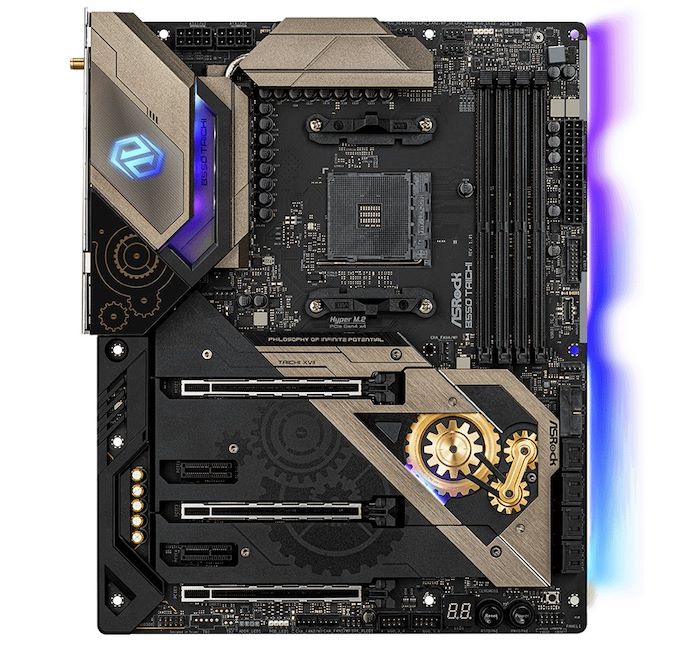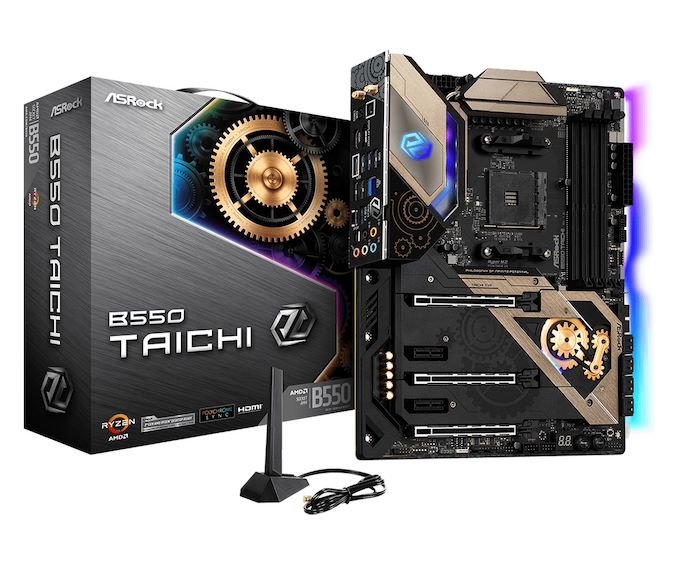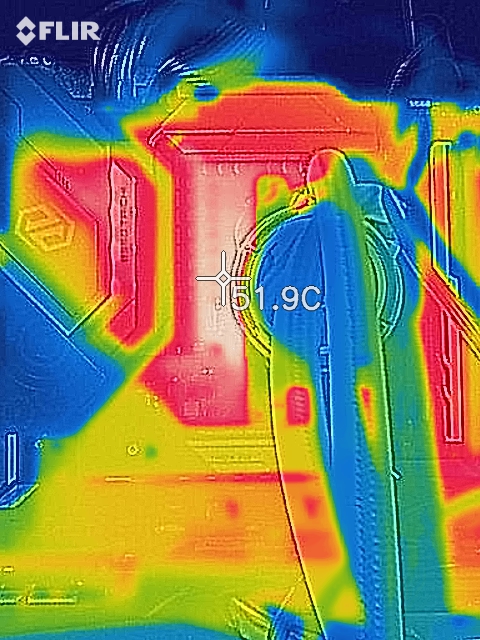ASRock B550 Taichi Review: The $300 B550 Motherboard with Chutzpah
by Gavin Bonshor on August 21, 2020 3:30 PM EST- Posted in
- Motherboards
- AMD
- ASRock
- Taichi
- AM4
- Ryzen 3000
- Ryzen 3700X
- Ryzen 4000
- B550
- B550 Taichi
_678x452.jpg)
Outside of its Aqua series of motherboards, which come with exquisitely crafted monoblocks, ASRock's Taichi brand has been a critical part of the company's offerings in the land of premium motherboards. The ASRock B550 Taichi sits at the top of its product stack and features an impressive quality feature set. Some of the most notable features include a large 16-phase power delivery, eight SATA ports, dual M.2 slots, an Intel 2.5 GbE Ethernet controller, and an Intel Wi-Fi 6 interface. At $300 it comes equal in price with the X570 version, which leaves questions on the table as to which one is actually worth the money.
When AMD first released the B550 chipset, a lot of fanfare was made about the high launch price of some models. For what has been usually considered a 'budget' chipset, some of the more premium B550 models cost more than some of the X570 models, which featured full support for PCIe 4.0 to add-in cards and the chipset. The B550 chipset has less PCIe 4.0 support than X570, with only the top full-length PCIe slot and one PCIe M.2 slot operating at PCIe 4.0, while the rest of the slots and chipset operate at PCIe 3.0. The trade-off is downstream bandwidth from the chipset as well as power, because the X570 requires a fan to keep that PCIe 4.0 chipset cool. Ultimately X570 requires 'more' to be fully enabled than B550, so it comes as a bit of surprise when the B550 and X570 models sit on equal pricing.
The ASRock B550 Taichi
Even with what has been said above, the ASRock B550 Taichi has all the hallmarks of a premium AM4 model with a solid array of controllers, ports, and power delivery.
Armed with its unique Taichi inspired design, the ASRock B550 Taichi follows a bronze and black color scheme with three customizable RGB LED zones. ASRock has installed the B550 Taichi with a large sixteen phase power delivery, which performs very well in our thermal testing. Unique to the ASRock range, the B550 Taichi is the only board where the top two PCIe slots support a PCIe 4.0 x8/x8 configuration - out of all other B550 boards, only two others have this feature.
Another solid benefit of the Taichi is that it includes a BIOS Flashback controller which allows users to update the firmware without a CPU installed. This is useful for when AMD launches Ryzen 4000 and a firmware update will be required to use the new Zen 3 processors. Some of the board's other core features include 2.5 GbE networking, Wi-Fi 6, and a premium audio codec with an assisting amplifier designed to bolster the quality of the front panel audio header.
After running our benchmarking suite, the ASRock B550 proved a consistent and solid performer in our testing. It displayed competitive performance in our system tests with strong power consumption figures in all three of our power tests, with a decent non-UEFI POST time of 20.6 seconds at default settings. In our CPU and gaming tests, the B550 Taichi performed competitively against other AM4 boards tested with our testbed Ryzen 7 3700X processor.
Our overclocking testing proved resourceful with a maximum stable overclock of 4.3 GHz with our Ryzen 7 3700X processor. Overall VDroop control was consistent throughout our testing, as was the performance in our POV-Ray benchmark testing. We saw equally impressive performance in our VRM thermal testing with the Taichi beating some of the more advanced and much more expensive X570 models. This is due to a more efficient power delivery design, as well as a solid pair of heatsinks which are interconnected via a single heat pipe for better heat dissipation. This is ultimately the reason why, despite being B550, this Taichi costs the same as the X570: better thermals and better power delivery.
The ASRock B550 Taichi as it stands is one of the most expensive B550 models with an MSRP of $300. This puts it up against ASRock's own X570 Taichi which currently costs $300 at Newegg. This puts the B550 Taichi in an awkward position in terms of value, with the X570 offering more raw features. However the B550 Taichi offers an alternative is the slightly larger power delivery (16-phase versus 14-phase), and an Intel 2.5 GbE Ethernet controller whereas the X570 Taichi is equipped with a standard Gigabit port.
Read on for our extended analysis and comparison tests.













61 Comments
View All Comments
Gigaplex - Saturday, August 22, 2020 - link
I just bought a B550 motherboard. It was 30% cheaper and had features that the X570 version didn't have (eg 2.5Gbit ethernet, better accoustics due to lack of a chipset fan).WaltC - Saturday, August 22, 2020 - link
$360 x570 Aorus Master is a far better buy. BTW, I've never heard the chipset fan even once. Got a lot more features than this B550 mboard. Had my x570 AM over a year and its doing great--and I still haven't seen anything better on the market--other than the Xtreme--which for me would be overkill and cost 2x as much.kkilobyte - Sunday, August 23, 2020 - link
Except when the Aorus Master suddenly refuses to boot, requiring you to remove the CMOS battery to revive it. Which is something that happens a bit too often - and Gigabyte still unable to solve the issue.Showtime - Monday, August 24, 2020 - link
When going AMD, they get you on the motherboards. You also need more expensive ram to maximize performance. I was interested in AMD this round, but the Intel non k chips give the same,or better gaming performance, and actually come out to the same or less depending on motherboard, and ram. $200+ b series mobo's are just bad investments IMO.yannigr2 - Friday, August 21, 2020 - link
Would you please check something about B550 X570 boards?Here the Taichi has the option to drive both top PCIe x16 slots from the CPU. IF I am not mistaken.
On the other hand the majority of B550 AND X570 boards seems to connect only the first PCIe x16 slot on the CPU and EVERYTHING ELSE on the chipset. Even if they have 2 or 3 PCIe x16 slots. That means that in many cases ports get disabled when other ports are populated.
hetzbh - Friday, August 21, 2020 - link
No AM4 based can drive 2 PCIe X16 from the CPU (I wish..) since the Ryzen 2xxx/3xxx has 24 PCIe lanes out from the CPU. 4 goes to the chipset, 4 goes to NVME M.2, and the last 16 goes to the first PCIe slot and can be shared (X8/X8) between 2 slots, but no X16/X16.yannigr2 - Friday, August 21, 2020 - link
I wasn't talking about driving two PCIe x16 ports. I was talking about splitting those 16 lanes to a typical x8 / x8 configuration.While this was the obvious case in most AM3 motherboards for example, in many cases, even with x570 boards with two or three PCIe X16 slots, only the first slot is connected to the CPU. The second (and third is their is one) PCIe x16 together with the couple x1 ports are connected in the Chipset. So you read. If you connected something in the second M2, you lose that PCIe slot. If you connect something in that PCIe slot, you lose the other PCIe slot and etc.
yannigr2 - Friday, August 21, 2020 - link
One example of a 570 that does thisASUS PRIME-X570-P
https://www.asus.com/Motherboards/PRIME-X570-P/spe...
1 x PCIe 4.0 x16 (x16 mode)
AMD X570 chipset
1 x PCIe 4.0 x16 (max at x4 mode)
3 x PCIe 4.0 x1
So, form the two PCIe x16, only the first is connected to the CPU. The second is connected on the chipset.
You have a microATX motherboard disguised as a full ATX.
Hyoyeon - Friday, August 21, 2020 - link
In order to bifurcate the x16, boards need some logic to mux/demux the lanes. Switching up to nearly 32 GB/s of traffic is quite hard, and so the IC's are surprisingly expensive (especially when you get into the really fast things like PCIe 5/6).eddman - Saturday, August 22, 2020 - link
That information can be gathered from the product's page on their website. The following is from this board's page:"single at Gen4x16 (PCIE1)
dual at Gen4x8 (PCIE1) / Gen4x8 (PCIE3)
triple at Gen4x8 (PCIE1) / Gen4x8 (PCIE3) / Gen3x4 (PCIE5)"
They don't specifically mention exactly which slot is connected to what, but from the above info it's apparent that the first two x16 slots are connected to the processor, because the lanes are split when two cards are inserted. The third slot is obviously connected to the chipset.
The Asus example you posted below clearly states the second slot is connected to the chipset.